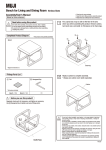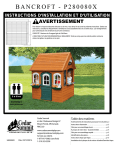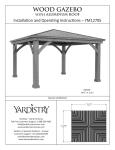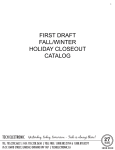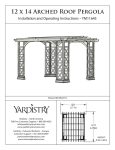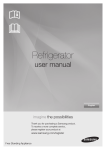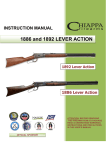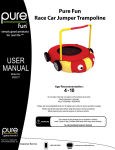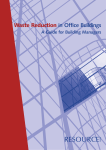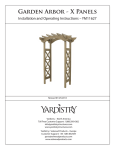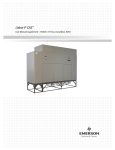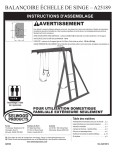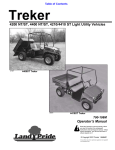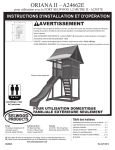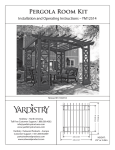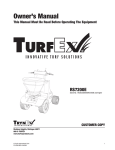Download Laurentian Instruction Manual
Transcript
L A U R E N T I A N P L AY S Y S T E M – F 2 3 2 8 0 INSTALLATION AND OPERATING INSTRUCTIONS WARNING 25'-3" To reduce the risk of serious injury or death, you must read and follow these instructions. Keep and refer to these instructions often and give them to any future owner of this play system. Manufacturer contact information provided below. 13'-3" 25'-10" 12'-9" OBSTACLE FREE SAFETY ZONE - 25’3” x 25’10” area requires Protective Surfacing. See page 3. MAXIMUM VERTICAL FALL HEIGHT - 6’5” CAPACITY - 10 Users Maximum, Ages 3 to 10; Weight Limit 110 lbs. (49.9 kg) per child. RESIDENTIAL HOME USE ONLY. Not intended for public areas such as schools, churches, nurseries, day cares or parks. Laurentian- H: 9ft 11inches Checked by: Jim/Ben 02-05-2014 8-10 Hrs Two person assembly Cedar Summit c/o ©Solowave Design L.P. Mount Forest, ON Canada N0G 2L0 3403280 www.cedarsummitplay.com [email protected] Customer Service 1-877-817-5682 (toll free) 1-519-323-2258 Table of Contents Warnings and Safe Play Instructions. . . . . . . . . . . . . . . pg. 2 Protective Surfacing Guidelines. . . . . . . . . . . . . . . . . . . pg. 3 Instructions for Proper Maintenance. . . . . . . . . . . . . . . pg. 4 About Our Wood – Limited Warranty . . . . . . . . . . . . . . pg. 5 Keys to Assembly Success. . . . . . . . . . . . . . . . . . . . . . pg. 6 Metric Conversion Sheets . . . . . . . . . . . . . . . . . . . . . . pg. 7,8 Part ID. . . . . . . . . . . . . . . . . . . . . . . . . . . . . . . . . . . . . . . pg. 9 Installation of I.D./Warning Plaque . . . . . . . . . . . . Final Step Rev 10/27/2014 Warnings and Safe Play Instructions CONTINUOUS ADULT SUPERVISION REQUIRED. Most serious injuries and deaths on playground equipment have occurred while children were unsupervised! Our products are designed to meet mandatory and voluntary safety standards. Complying with all warnings and recommendations in these instructions will reduce the risk of serious or fatal injury to children using this play system. Go over the warnings and safe play instructions regularly with your children and make certain that they understand and follow them. Remember on-site adult supervision is required for children of all ages. WARNING SERIOUS HEAD INJURY HAZARD Installation over concrete, asphalt, dirt, grass, carpet and other hard surface creates a risk of serious injury or death from falls to the ground. Install and maintain shock absorbing material under and around play-set as recommended on page 3 of these instructions. STRANGULATION HAZARD • NEVER allow children to play with ropes, clotheslines, pet leashes, cables, chains or cord-like items when using this play-set or to attach these items to play-set. • NEVER allow children to wear loose fitting clothing, ponchos, hoods, scarves, capes, necklaces, items with draw-strings, cords or ties when using this play-set. • NEVER allow children to wear bike or sport helmets when using this play-set. COLLISION HAZARD Place play-set on level ground at least 6 feet from any obstruction such as a garage or house, fences, poles, trees, sidewalks, walls, landscape timbers, rocks, pavement, planters, garden borders, overhanging branches, laundry lines, and electrical wires. (See OBSTACLE FREE SAFETY ZONE on cover) Failure to prohibit these items, even helmets with chin straps, increases the risk of serious injury and death to children from entanglement and strangulation. TIP OVER HAZARD Choose a level location for the equipment. This can reduce the likelihood of the play set tipping over and loose-fill surfacing materials washing away during heavy rains. CHOKING HAZARD/SHARP EDGES & POINTS Adult assembly required. This product contains small parts and parts with sharp edges and points. Keep parts away from children until fully assembled. DO NOT allow children to play on the play-set until the assembly is complete and the unit is properly anchored. WARNING LABEL Owners shall be responsible for maintaining the legibility of the warning labels. WARNING – Safe Play Instructions Observe capacity limitations of your play-set. See front cover. Do not allow children to wear open toe or heel footwear like sandals, flip–flops or clogs. Dress children with well fitting and full foot enclosing footwear. Do not allow children to walk, in front, between, behind or close to moving rides. Teach children to sit with their full weight in the center of the swing seat to prevent erratic swing motion or falling off. Do not let children twist swing chains or ropes or loop them over the top support bar. This may reduce the strength of the chain or rope and cause premature failure. Check for splintered, broken or cracked wood; missing, loose, or sharp edged hardware. Replace, tighten and or sand smooth as required prior to playing. Do not let children get off rides while they are in motion. Do not permit climbing on equipment when it is wet. Do not permit rough play or use of equipment in a manner for which it was not intended. Standing on or jumping from the roof, elevated platforms, swings, climbers, ladders or slide can be dangerous. Verify that suspended climbing ropes, rope ladders, chain or cable are secured at both ends and cannot be looped back on itself as to create an entanglement hazard. On sunny and or hot days, check the slide and other plastic rides to assure that they are not very hot as to cause burns. Cool hot slide and rides with water and wipe dry prior to using. Do not allow children to swing empty rides or seats. Do not allow children to go down slide head first or run up slide. 2 2 [email protected] Protective Surfacing - Reducing Risk of Serious Head Injury From Falls One of the most important things you can do to reduce the likelihood of serious head injuries is to install shock-absorbing protective surfacing under and around your play equipment. The protective surfacing should be applied to a depth that is suitable for the equipment height in accordance with ASTM F1292. There are different types of surfacing to choose from; whichever product you select, follow these guidelines: Loose-Fill Materials • Maintain a minimum depth of 9 inches of loose-fill materials such as wood mulch/chips, engineered wood fiber (EWF), or shredded/recycled rubber mulch for equipment up to 8 feet high; and 9 inches of sand or pea gravel for equipment up to 5 feet high. NOTE: An initial fill level of 12 inches will compress to about a 9-inch depth of surfacing over time. The surfacing will also compact, displace, and settle, and should be periodically raked and refilled to maintain at least a 9-inch depth. • Use a minimum of 6 inches of protective surfacing for play equipment less than 4 feet in height. If maintained properly, this should be adequate. (At depths less than 6 inches, the protective material is too easily displaced or compacted.) NOTE: Do not install home playground equipment over concrete, asphalt, or any other hard surface. A fall onto a hard surface can result in serious injury to the equipment user. Grass and dirt are not considered protective surfacing because wear and environmental factors can reduce their shock absorbing effectiveness. Carpeting and thin mats are not adequate protective surfacing. Ground level equipment -- such as a sandbox, activity wall, playhouse or other equipment that has no elevated play surface -- does not need any protective surfacing. • Use containment, such as digging out around the perimeter and/or lining the perimeter with landscape edging. Don’t forget to account for water drainage. • Periodically rake, check and maintain the depth of the loose-fill surfacing material. Marking the correct depth on the play equipment support posts will help you to see when the material has settled and needs to be raked and or replenished. Be sure to rake and evenly redistribute the surfacing in heavily used areas. • Do not install loose fill surfacing over hard surfaces such as concrete or asphalt. Poured-In-Place Surfaces or Pre-Manufactured Rubber Tiles You may be interested in using surfacing other than loose-fill materials - like rubber tiles or poured-in-place surfaces. • Installations of these surfaces generally require a professional and are not “do-it yourself ” projects. • Review surface specifications before purchasing this type of surfacing. Ask the installer/manufacturer for a report showing that the product has been tested to the following safety standard: ASTM F1292 Standard Specification for Impact Attenuation of Surfacing Materials within the Use Zone of Playground Equipment. This report should show the specific height for which the surface is intended to protect against serious head injury. This height should be equal to or greater than the fall height - vertical distance between a designated play surface (elevated surface for standing, sitting, or climbing) and the protective surfacing below - of your play equipment. • Check the protective surfacing frequently for wear. Placement Proper placement and maintenance of protective surfacing is essential. Refer to diagram on front cover. Be sure to; • Extend surfacing at least 6 feet from the equipment in all directions. • For to-fro swings, extend protective surfacing in front of and behind the swing to a distance equal to twice the height of the top bar from which the swing is suspended. • For tire swings, extend surfacing in a circle whose radius is equal to the height of the suspending chain or rope, plus 6 feet in all directions. 6 ft. Denotes Use Zone with Protective Surfacing 6 ft. 6 ft. 6 ft. 6 ft. 6 ft. Denotes Use Zone with Protective Surfacing 6 ft. Use Zone for Single-Axis Swings Use Zone for Multi-Axis Swings From the CPSC Outdoor Home Playground Safety Handbook. At http://www.playgroundregs.com/resources/CPSC%20324.pdf 3 [email protected] Instructions for Proper Maintenance Your Cedar Summit Play System is designed and constructed of quality materials with your child’s safety in mind. As with all outdoor products used by children, it will weather and wear. To maximize the enjoyment, safety and life of your Play Set, it is important that you, the owner, properly maintain it. Check the following at the beginning of the play season: HARDWARE: Check metal parts for rust. If found, sand and repaint using a non-lead paint complying with 16 CFR 1303. Inspect and tighten all hardware. On wood assemblies DO NOT OVERTIGHTEN as to cause crushing and splintering of wood. Check for sharp edges or protruding screw threads, add washers if required. If Bolt protrudes beyond T-Nut Use an extra flat washer SHOCK ABSORBING SURFACING: Check for foreign objects. Rake and check depth of loose fill protective surfacing materials to prevent compaction and maintain appropriate depth. Replace as necessary. (See Protective Surfacing, page 3) GROUND STAKES (ANCHORS): Check for looseness, damage or deterioration. Should firmly anchor unit to ground during use. Re-secure and or replace, if necessary. SWING HANGERS: Check that bolts are secure and tight. Quick clips should be completely closed and threaded clips screwed tight. If squeaking occurs lubricate bushings with oil or WD-40®. SWINGS, ROPES AND RIDES: Reinstall if removed during cold season. Check all moving parts including swing seats, ropes, chains and attachments for wear, rust and other deterioration. Replace as needed. Check that ropes are tight, secure at both ends and cannot loop back as to create an entrapment. WOOD PARTS: Check all wood members for deterioration, structural damage and splintering. Sand down splinters and replace deteriorated wood members. As with all wood, some checking and small cracks in grain is normal. Applying a water repellent or stain (water-based) on a yearly basis is important maintenance to maintain maximum life and performance of the product. Check twice a month during play season: HARDWARE: Inspect for tightness. Must be firmly against, but not crushing the wood. DO NOT OVER-TIGHTEN. This will cause splintering of wood. Check for sharp edges or protruding screw threads. Add washers if required. SHOCK ABSORBING SURFACING: Rake and check depth of loose fill protective surfacing materials to prevent compaction and maintain appropriate depth. Replace as necessary. (See Protective Surfacing, page 3) Check once a month during play season: SWING HANGERS: Check that they are secure and orientated correctly. Hook should rotate freely and perpendicular to support beam. If squeaking occurs lubricate bushings with oil or WD-40®. SWINGS AND RIDES: Check swing seats, all ropes, chains and attachments for fraying, wear, excessive corrosion or damage. Replace if structurally damaged or deteriorated. Check at the end of the play season: SWINGS AND RIDES: To prolong their life, remove swings and store inside when outside temperature is below 32°F/0°C. Below freezing, plastic parts may become more brittle. SHOCK ABSORBING SURFACING: Rake and check depth of loose fill protective surfacing materials to prevent compaction and maintain appropriate depth. Replace as necessary. (See Protective Surfacing, page 3) If you dispose of your play set: Please disassemble and dispose of your unit so that it does not create any unreasonable hazards at the time it is discarded. Be sure to follow your local waste ordinances. 4 [email protected] About Our Wood Cedar Summit Premium Play Systems uses only premium playset lumber, ensuring the safest product for your children’s use. Although we take great care in selecting the best quality lumber available, wood is still a product of nature and susceptible to weathering which can change the appearance of your set. What causes weathering? Does it affect the strength of my Play System? One of the main reasons for weathering is the effects of water (moisture); the moisture content of the wood at the surface is different than the interior of the wood. As the climate changes, moisture moves in or out of the wood, causing tension which can result in checking and or warping. You can expect the following due to weathering. These changes will not affect the strength of the product: 1. Checking is surface cracks in the wood along the grain. A post (4” x 4”) will experience more checking than a board (1” x 4”) because the surface and interior moisture content will vary more widely than in thinner wood. 2. Warping results from any distortion (twisting, cupping) from the original plane of the board and often happens from rapid wetting and drying of the wood. 3. Fading happens as a natural change in the wood color as it is exposed to sun-light and will turn a grey over time. How can I reduce the amount of weathering to my Play System? At the factory we have coated the wood with a water repellent or stain. This coating decreases the amount of water absorption during rain or snow thus decreasing the tension in the wood. Sunlight will break down the coating, applying a water repellant or stain on a yearly basis is important maintenance. (see your local stain and paint supplier for a recommended product) Most weathering is just the normal result of nature and will not affect safe play and enjoyment for your child. However if you are concerned that a part has experienced a severe weathering problem please call our consumer relations department for further assistance. Complete and mail registration card to receive important product notifications and assure prompt warranty service. 5 Year Limited Warranty Solowave Design warrants that this product is free from defect in materials and workmanship for a period of one year from the original date of purchase. In addition, lumber is warranted for 5 years against structural failure due to rot and insect damage. All other parts, such as hardware, swings, rides, accessories, and slides carry a one-year warranty only. This warranty applies to the original owner and registrant and is non-transferable. Regular maintenance is required to assure the integrity of your Play System. Failure by the owner to maintain the product according to the maintenance requirements may void this warranty. This warranty does not cover any inspection cost. This Limited Warranty does not cover: • Labor for replacement of any defective item(s); • Incidental or consequential damages; • Cosmetic defects which do not affect performance or integrity; • Vandalism; improper use or installation; acts of nature; • Minor twisting, warping, checking, or any other natural occurring properties of wood that do not affect performance or integrity. Solowave Design products have been designed for safety and quality. Any modifications made to the original product could damage the structural integrity of the unit leading to failure and possible injury. Solowave Design Inc. cannot assume any responsibility for modified products. Furthermore, modification voids any and all warranties. This product is warranted for RESIDENTIAL USE ONLY. Under no circumstance should a Solowave Design Play System be used in public settings such as schools, churches, playgrounds, parks, day cares and the like. Such use may lead to product failure and potential injury. Any and all public use will void this warranty. Solowave Design disclaims all other representations and warranties of any kind, express or implied. This Warranty gives you specific legal rights. You may have other rights as well which vary from state to state or province to province. This warranty excludes all consequential damages, however, some states do not allow the limitation or exclusion of consequential damages, and therefore this limitation may not apply to you. 5 [email protected] Keys to Assembly Success Tools Required • Tape Measure • Carpenters Level • Carpenters Square • Claw Hammer • Standard or Cordless Drill Part Identification Key On each page, you will find the parts and quantities required to complete the assembly step illustrated on that page. Here is a sample. • 3/16” Hex Key • 8’ Step Ladder • Safety Glasses • Adult Helpers • Pencil • Open End Wrench (1/2” & 9/16”) • Adjustable Wrench • 1/8” & 3/16” Drill Bits • #1 Phillips, #2 Robertson and Screwdriver • Ratchet with extension (1/2” & 9/16” sockets) Key Number: The first two digits represent the step number. The third digit represents the piece. Note that if the part is used in multiple steps then the number only reflects the first step it is used in. 2X 012 Post 2 x 4 x 83” Quantity Key Number Part Description, Part Size Symbols Throughout these instructions symbols are provided as important reminders for proper and safe assembly. Check that set or assembly is properly level before proceeding. This identifies information that requires special attention. Improper assembly could lead to an unsafe or dangerous condition. Use Help Measure Distance Use Help Pre-drill 1/8” & 3/16” Bit Where this is shown, 2 or 3 people are required to safely complete the step. To avoid injury or damage to the assembly make sure to get help! Check that assembly is square before tightening bolts. Pre-drill a pilot hole before fastening screw or lag to prevent splitting of wood. Tighten Bolts Square Assembly This indicates time to tighten bolts, but not too tight! Do not crush the wood. This may create splinters and cause structural damage. Use a measuring tape to assure proper location. No CAUTION – Protrusion Hazard For bolts, tap T-Nut into hole with hammer. Insert the hex bolt through lock washer first then flat washer then hole. Because the assemblies need to be squared do not completely tighten until instructed. Pay close attention to diameter of the bolts. 5/16” is slightly larger than 1/4”. Note: Wafer head bolts with blue lock tight or a bolt with a Ny-Lok nut do NOT require a lock washer. Yes If Bolt protrudes beyond T-Nut Once the assembly is tightened, watch for exposed threads. If a thread protrudes from the T-Nut, remove the bolt and add washers to eliminate this condition. Extra washers have been provided for this purpose. Proper Hardware Assembly Lag screws require drilling pilot holes to avoid splitting wood. Only a flat washer is required. For ease of installation liquid soap can be used on all lag-type screws. Use Level Use an extra flat washer Lag Assembly Lag Screw Before mounting Lag Screw, use factory drilled holes as guides to drill 1/8” pilot holes Flat Washer Bolt Assembly Hex Bolt Lock Washer Flat Washer 6 T-Nut (Hammer into place) Do not crush wood! [email protected] 5/16" (8mm) Flat Washer 1/4" (6mm) Lock Washer 5/16" (8mm) T-Nut 1/4" (6mm) T-Nut 1/4" (6mm) Flat Washer 5/16" (8mm) Flat Washer For example: BOLT LENGTH 4½ (4.5) inches long 1 inch = 25.4mm LENGTH CONVERSION 0.31 inches x 25.4mm = 8mm BOLT DIAMETER 5/16 (0.31) inches For example: 1 inch = 25.4mm DIAMETER CONVERSION HARDWARE LENGTH CHART inches vs millimetres 6 152 5½ 140 5 127 114 4½ 4 102 3½ 89 3 76 2½ 64 2 51 1½ 38 1¼ 32 1-1/8 29 1 25.4 7/8 22 3/4 19 1/2 12.7 SOLO)WAVE DESIGN HARDWARE 5/16"(.31) = 8mm Hex Bolt 5/16" (8mm) Lock Washer 1/4"(0.25) = 6mm Hex Bolt 1/4" (6mm) Flat Washer 1/4"(0.25) = 6mm Lag Screw 5/16"(.31) = 8mm Lag Screw 3/8"(.38) = 9.5mm Lag Screw 3/8" (9.5mm) Flat Washer 4.5 inches x 25.4mm = 114mm long [email protected] 7 63.5 2 1/2" 5/4 x 3 88.9 3 1/2" 5/4 x 4 114.3 4 1/2" 5/4 x 5 139.7 5 1/2" 5/4 x 6 88.9 3 1/2" 4x4 38.1 1 1/2" 34.9 1 3/8" 34.9 1 3/8" 38.1 1 1/2" 38.1 1 1/2" 2x6 136.5 5 3/8" 2x4 85.7 3 3/8" 2x3 63.5 2 1/2" 2 x2 15.9 5/8" 82.6 3 1/4" 34.9 1 3/8" 60.3 2 3/8" 85.7 3 3/8" 114.3 4 1/2" 136.5 5 3/8" 1/2 x 4 1x2 1x3 1x4 1x5 1x6 LENGTH CONVERSION 1 inch = 25.4mm 59.25 inches x 25.4mm = 1505mm For example: BOARD LENGTH 59¼ (59.25) inches 15.9 5/8" 15.9 5/8" 15.9 5/8" 15.9 5/8" 11.1 .44 SOLO)WAVE DESIGN WOOD PROFILES 25.4 1" 25.4 1" 25.4 1" 25.4 1" 88.9 3 1/2" Dimensions in brackets [mm] represent millimetres. [email protected] 8 Part Identification (Reduced Part Size) 4pc. - 2545 - CE Siding 3/8 x 3-1/2 x 35-7/8" - 3632545 - Box 2 Nominal Size Actual Size 3/8 x 3-1/2 1/2 x 4 1x2 1x3 1x4 12pc. - 1503 - Wall Board 1/2 x 4 x 20" - 3631503 - Box 1&2 3/8 x 3-1/2 5/8 x 3-1/4 5/8 x 1-3/8 5/8 x 2-3/8 5/8 x 3-3/8 2pc. - 2535 - Clock Roof Support 1 x 2 x 18-1/8" - 3632535 - Box 2 2pc. - 2550 - Counter Top 1 x 2 x 29-1/8" - 3632550 - Box 2 2pc. - 6836 - Counter Side - 5/8 x 2 x 6-7/8" - 38036836 - Box 2 1pc. - 2549 - Counter Front 1 x 3 x 29-1/8" - 3632549 - Box 2 2pc. - 2544 - Counter Middle 1 x 4 x 6-1/8" - 3632544 - Box 2 1pc. - 2551 - Clock Roof B 1 x 4 x 18-1/8" - 3632551 - Box 2 1pc. - 2543 - Clock Roof A 1 x 4 x 18-3/4" - 3632543 - Box 2 2pc. - 1227 - CE Wall Board 1 x 4 x 20" - 3631227 - Box 2 3pc. - 0304 - CE Floor Board 1 x 4 x 32-1/2" - 3630304 - Box 1 3pc. - 2533 - Kitchen Wall Support 1 x 4 x 35-7/8" - 3632533 - Box 2 1pc. - 2034 - Wall Support 1 x 4 x 35 7/8" - 3642034 - Box 2 1pc. - 0839 - CE Gap Board 1 x 4 x 38-3/4" - 3630839 - Box 2 1pc. - 2536 - Kitchen Side 1 x 4 x 46-3/4" - 3632536 - Box 2 1pc. - 2552 - SW Side 1 x 4 x 46-3/4" - 3632552 - Box 2 2pc. - 2532 - Top Front Back 1 x 4 x 53-1/4" - 3632532 - Box 2 9 [email protected] Part Identification (Reduced Part Size) 1pc. - 0353 - MK Ground 1 x 4 x 55 1/4" - 3640353 - Box 2 Nominal Size 1x4 1x5 1x6 1pc. - 1895 - Floor End 1 x 5 x 35 1/4" - 3641895 - Box 2 Actual Size 5/8 5/8 5/8 x 3-3/8 x 4-3/8 x 5-3/8 1pc. - 2032 - End Floor 1 x 5 x 35 1/4" - 3642032 - Box 2 1pc. - 2538 - Ground Cafe 1 x 5 x 35-7/8" - 3632538 - Box 2 2pc. - 1768 - Lower Back 1 x 5 x 38 1/2" - 3641768 - Box 2 1pc. - 2037 - Front Top 1 x 5 x 38 1/2" - 3642037 - Box 2 1pc. - 2029 - Ground SW 1 x 5 x 72" - 3642029 - Box 2 2pc. - 1779 - CE Access Board 1 x 6 x 17" - 3631779 - Box 2 2pc. - 1778 - CE Rock Board A 1 x 6 x 17" - 3631778 - Box 2 3pc. - 1777 - CE Rock Board B 1 x 6 x 17" - 3631777 - Box 1 1pc. - 2547 - Table Top 1 x 6 x 31" - 3632547 - Box 1 5pc. - 1889 - Floor Board 1 x 6 x 32½" - 3631889 - Box 2 2pc. - 1890 - CE Gap Board 1 x 6 x 32½" - 3631890 - Box 2 10 [email protected] Part Identification (Reduced Part Size) 1pc. - 9836 - Bench Brace Top 5/4 x 4 x 6-1/2" - 38039836 - Box 2 2pc. - 9136 - Bench End Support Cafe 5/4 x 4 x 7" - 38039136 - Box 2 Nominal Size Actual Size 5/4 x 4 2x3 2x4 15/16 x 3-1/4 1-3/8 x 2-1/2 1-3/8 x 3-3/8 2pc. - 9936 - Bench Leg Cafe 5/4 x 4 x 11" - 38039936 - Box 1 2pc. - 9236 - Bench Base Cafe 5/4 x 4 x 16" - 38039236 - Box 2 2pc. - 4836 - Bench Top Cafe 5/4 x 4 x 31-7/16" - 38034836 - Box 2 1pc. - 1903 - Floor Joist 5/4 x 3 x 38-1/2" - 3641903 - Box 2 2pc. - 2548 - Gusset 5/4 x 4 x 8" - 3632548 - Box 2 2pc. - 2546 - Table Support 5/4 x 4 x 15-3/4" - 3632546 - Box 2 1pc. - 2534 - Back Board 5/4 x 4 x 27-1/8" - 3632534 - Box 2 1pc. - 1894 - Back Floor 5/4 x 4 x 38 1/2" - 3641894 - Box 2 1pc. - 1862 - SW Support 5/4 x 4 x 46 1/2" - 3641862 - Box 2 1pc. - 2537 - Counter Joist 2 x 3 x 8-1/2" - 3632537 - Box 2 1pc. - 0312 - Gusset 2 x 3 x 16" - 3640312 - Box 2 4pc. - 0369 - Lower Diagonal 2 x 3 x 37" - 3640369 - Box 2 1pc. - 1908 - Front Floor 2 x 3 x 38 1/2" - 3641908 - Box 2 2pc. - 0349 - Rock Rail 2 x 3 x 51" - 3640349 - Box 2 1pc. - 2531 - MK Mount 2 x 3 x 60-3/8" - 3632531 - Box 2 2pc. - 1367 - Post MK 2 x 3 x 70" - 3641367 - Box 2 1pc. - 2539 - SW Mount 2 x 4 x 36" - 3632539 - Box 2 1pc. - 4919 - SW Rail Block 2 x 4 x 5 3/8" - 3644919 - Box 2 1pc. - 1856 - SW Upright 2 x 4 x 48 5/16" - 3641856 - Box 2 1pc. - 1565 - MK Rail Short 2 x 4 x 50" - 3641565 - Box 2 1pc. - 1943 - MK Rail Long 2 x 4 x 54" - 3641943 - Box 2 4pc. - 1931 - Post 2 x 4 x 81" - 3641931 - Box 2 11 [email protected] Part Identification (Reduced Part Size) 2pc. - 1863 - SW Post 2 x 4 x 86 11/16" - 3641863 - Box 2 1pc. - 1761 - Side Joist 2 x 2 x 34 3/4" - 3641761 - Box 2 Nominal Size 2x4 2x2 2x6 Actual Size 1-3/8 x 3-3/8 1-1/2 x 1-1/2 1-1/2 x 5-3/8 1pc. - 2540 - Top Wall Support 2 x 2 x 35-7/8" - 3632540 - Box 2 1pc. - 2541 - Roof Ridge 2 x 2 x 46-3/4" - 3632541 - Box 2 1pc. - 2542 - Roof Upright 2 x 2 x 60"- 3632542 - Box 2 1pc. - 1825 - Back Beam 2 x 6 x 83 5/8" - 3631825 - Box 2 1pc. - 1826 - Front Beam 2 x 6 x 83 5/8" - 3631826 - Box 2 12 [email protected] Hardware Identification (Actual Size) 4pc. LS1 - Lag Screw 1/4 x 1-1/2" - (9262212) 3pc. LS2 - Lag Screw 1/4 x 2-1/2" - (9272222) 10pc. LS3 - Lag Screw 1/4 x 3" - (9262230) 26pc. H2 - Hex Bolt 1/4 x 2" - (9277220) 2pc. H3 - Hex Bolt 1/4 x 2-1/2" - (9277222) 1pc. H13 - Hex Bolt 1/4 x 3-1/2" - (9277232) 4pc. H12 - Hex Bolt 1/4 x 3" - (9277230) 5pc. - PB2 -Pan Bolt 1/4 x 1 1/4 - (9274211) 1pc. H8 - Hex Bolt 1/4 x 4-1/4" - (9277241) 2pc. H5 - Hex Bolt 1/4 x 4-1/2" - (9277242) 2pc. H6 - Hex Bolt 1/4 x 4-3/4" - (9277243) 4pc. H7 - Hex Bolt 1/4 x 5-1/2" - (9277252) 4pc. G1 - Hex Bolt 5/16 x 1-1/2" - (9277312) 2pc. G8 - Hex Bolt 5/16 x 2" - (9277320) 3pc. G10 - Hex Bolt 5/16 x 3" - (9277330) 5pc. G4 - Hex Bolt 5/16 x 4" - (9277340) 13 [email protected] Hardware Identification (Actual Size) 5pc. - G5 -Hex Bolt 5/16 x 4 1/2" - (9277342) 1pc. D4 -#2 x 2" Robertson Driver - (9200014) 4pc. - G7 -Hex Bolt 5/16 x 5 1/2" - (9277352) 2pc. 5/16" Glider Long Bolt Bolt may not be exactly as it appears 17pc. LW2 - 5/16" Lock Washer - (9253300) 47pc. LW1 -1/4" Lock Washer - (9253200) 59pc. FW1 -1/4" Flat Washer - (9251200) 5pc. BN1 -1/4" Barrel Nut - (9248200) 42pc. FW2 - 5/16" Flat Washer - (9251300) 42pc. TN1 - 1/4" T - Nut -(9285200) 12pc. LN2 -5/16" Lock Nut - (9283300) 44pc. FW3 -#8 Flat Washer - (9251500) 17pc. TN2 -5/16" T- Nut - (9285300) 28pc. - TS -Trim Screw - #6 x 30mm - (922911) 4pc. - S16 -Pan Screw #6 x 1" - (9264010) 19pc. FW0 -3/16" Flat Washer - (9251100) 64pc. - S0 -Truss Screw #8 x 7/8" - (9229505) 68pc. - S5 -Pan Screw #8 x 1/2" - (9264504) 5pc. - S10 -Pan Screw #8 x 1" - (9264510) 14pc. - S6 -Pan Screw #12 x 1" - (9264610) 19pc. - S7 -Pan Screw #12 x 2" - (9264620) 20pc. - S1 -Flat Head Screw #8 x 1 1/8" - (52042514) 105pc. - S2 -Flat Head Screw #8 x 1 1/2" - (9260512) 22pc. - S15 -Flat Head Screw #8 x 1 3/4" - (9260513) 30pc. - S3 -Flat Head Screw #8 x 2 1/2" - (9290522) 8pc. - S4 -Flat Head Screw #8 x 3" - (9290530) 14 [email protected] Part Identification (Reduced Part Size) 3pc. - 578 - Dowel Tennon 1 1/8 x 15 7/8" - 3681578 - Box 1 1pc. - 858 - Dowel Tennon 1 1/8 x 18 5/8" - 3681858 - Box 1 6pc. - 0318 - Ground Stake 1 1/4 x 1 1/2 x 14" - 3650318 - Box 1 1X 3320124 Clock Assembly 1X 3533860 39" Glider Rope & Chain (4pk) w. welded chain 1X 3320132 Flag and Pole (2Pk) 1X 3320386 Rocks (5pk) 3-Green 2-Yellow 1X 9320357 Cedar Summit I.D Plaque 1X 3200184 Triangle Plate (4pk) Green 2X Glider End 1X 9200140 MB Mount Strap Green 3X 9200300 MK Bracket Green 1X 3201305 Monkey Bracket Set 1X Glider Seat 1X 3320969 Deluxe Kitchen Set 1X 3200202 Glider Hanger (2pk) 1X 3200166 Corner Brace Set (6pk) Green 2X 3724943 42" Belt Swing Yellow w.welded chain 1 x 3753280 Laurentian Canopy Set 1X 3202000 Swing Hanger Bolt Thru. (4pk) 1 x 9750180 Wrap Around Tarp I Green 1 x 9750124 Clock Tarp Green 1 x 9750181 Wrap Around Tarp II Green 1 x 9753280 Laurentian Canopy Green 15 1X 3310248 Slide 48" High Rail - Yellow [email protected] Step 1: Inventory Parts - Read This Before Starting Assembly STOP STOP STOP STOP A. This is the time for you to inventory all your hardware, wood and accessories, referencing the parts identification sheets. This will assist you with your assembly. • The wood pieces will have the four digit key number stamped on the ends of the boards. The wood pieces are referenced throughout the instructions with this number. • Please refer to Page 6 for proper hardware assembly. • Each step indicates which bolts and/or screws you will need for assembly, as well as any flat washers, lock washers, t-nuts or lock nuts. B. If there are any missing or damaged pieces or you need assistance with assembly please contact the Consumer Relations Department directly. Call us before going back to the store. 1-877-966-3738 [email protected] C. R ead the assembly manual completely, paying special attention to ANSI warnings; notes; and safety/maintenance information on pages 1 - 6. D. B efore you discard your cartons fill out the form below. • The carton I.D. stamp is located on the end of each carton. The tracking number is located on the ID Plaque. • Please retain this information for future reference. You will need this information if you contact the Consumer Relations Department. MODEL NUMBER: F23280 CARTON I.D. STAMP: __ __ __ __ __ 14459 ___ (Box 1) CARTON I.D. STAMP: __ __ __ __ __ 14459 ___ (Box 4) CARTON I.D. STAMP: __ __ __ __ __ 14459 ___ (Box 2) CARTON I.D. STAMP: __ __ __ __ __ 14459 ___ (Box 5) CARTON I.D. STAMP: __ __ __ __ __ 14459 ___ (Box 3) CARTON I.D. STAMP: __ __ __ __ __ 14459 ___ (Box 6) TRACKING NUMBER (from ID Plaque): 16 [email protected] Step 2: Rock Wall Assembly Note: The holes in the rock boards must orient to the top of the boards. Fig. 2.1 1778 1777 1779 S2 1778 1777 1777 0349 7-3/4” Approx Note: Gaps between boards 2-1/4”, not to exceed 2-3/8” A: Lay 2 (0349) Rock Rails down, side by side with angled edges facing down. (fig. 2.1) B: Place (1779) CE Access Board on the bottom of each (0349) Rock Rail as shown in fig. 2.1. Make sure (1779) CE Access Board is flush to the outside and bottom edges of each (0349). Attach using 4 (S2) #8 x 1-1/2” Wood Screws. C: 7-3/4” down from the top of both (0349) Rock Rails place 1 (1777) CE Rock Board B, making sure the sides are flush to the outside edges of each (0349) Rock Rail. Attach using 4 (S2) #8 x 1-1/2” Wood Screws. (fig. 2.1) D: In between the (1779) CE Access Board and (1777) CE Rock Board B stagger 2 (1778) and 2 (1777) CE Rock Boards A & B using 4 (S2) #8 x 1-1/2” Wood Screws per board. Placing them as shown in fig. 2.1, this will prevent rocks from forming a straight line. Make sure the boards are evenly spaced and do not exceed 2-3/8” between boards. Fig. 2.2 PB2 1/4” Lock Washer Fig. 2.3 E: Place 1 rock on each (1777) and (1778) CE Rock Board A & B (fig. 2.2) and attach using 1 (PB2) 1/4 x 1-1/4” Pan Bolt (with lock washer, flat washer and barrel nut) and 1 (S10) #8 x 1” Pan Screw per rock. The Screw must be in the hole directly under the Pan Bolt, it will stop the rock from spinning. (fig. 2.3) S10 3/16” Flat Washer Rock 1/4” Barrel Nut Wood Parts Hardware Other Parts S2 #8 x 1-1/2” Wood Screw 5 x Rocks (3 green/2 yellow) S10 #8 x 1” Pan Screw CE Access Board 1 x 6 x 17” 24 x 3 x 1777 CE Rock Board B 1 x 6 x 17” 5 x 5 x PB2 1 x 1779 2 x 1778 CE Rock Board A 1 x 6 x 17” 2 x 0349 Rock Rail 2 x 3 x 51” 1/4 x 1-1/4 Pan Bolt (1/4” lock washer, 3/16” flat washer & 1/4” barrel nut) 17 [email protected] Step 3: Swing Beam Assembly WARNING: Fig. 3.4 For your child’s safety, orientate the swing hangers as shown to ensure your swing will have proper swing motion when installed. Failure to do so could result in premature failure of the swing hanger or swing chain. Make sure triangle is tight against beam A: In the middle holes of (1825) Back Beam install 2 Bolt-Thru Swing Hangers (fig. 3.1) making sure the swing hangers are oriented in the direction shown in fig. 3.4 to maintain proper swing motion. B: In the end holes of (1826) Front Beam install 2 Bolt-Thru Swing Hangers (fig. 3.1) making sure the swing hangers are oriented in the direction shown in fig. 3.4 to maintain proper swing motion. Bolt-Thru Swing Hangers 1825 Bolt-Thru Swing Hangers Fig. 3.1 Make sure holes are aligned. 1826 Fig. 3.2 C: Attach 1 Triangle Plate to the ends of each (1826) Front Beam and (1825) Back Beam using 1 (G1) 5/16 x 1-1/2” Hex Bolt (with lock washer, flat washer and t-nut) per triangle plate in the hole indicated in fig. 3.2 & 3.3. Correct hole usage is very important. Important! Fort End Side (No Overhang) Important! Swing End (With Overhang) 1826 G1 Fig. 3.3 1/4” T-Nut G1 1825 5/16” Flat Washer 1/4” Flat Washer H7 Swing End (With Overhang) 1826 Front Beam 2 x 6 x 83-5/8” 1 x 1825 Back Beam 2 x 6 x 83-5/8” G1 D: Attach 1 (H7) 1/4 x 5-1/2” Hex Bolt (with lock washer, flat washer and t-nut) to the ends of each (1826) Front Beam and (1825) Back Beam. The bolts do not attach to anything, but MUST be installed to the beams to prevent splitting and checking of wood. (fig. 3.2 & 3.3) Fort End Side (No Overhang) Wood Parts 1 x 5/16” Lock Washer G1 5/16” T-Nut 1/4” Lock Washer H7 H7 Triangle Plates H7 Other Parts Hardware 4 x H7 1/4 x 5-1/2” Hex Bolt (1/4” flat washer, 1/4” lock washer, 1/4” t-nut) 4 x G1 5/16 x 1-1/2” Hex Bolt (5/16” flat washer, 5/16” lock washer, 5/16” t-nut) 18 1 x Bolt-Thru Swing Hangers (pkg of 4) 1 x Triangle Plate (pkg of 4) [email protected] Step 4: Swing End Assembly A: Attach 2 (1863) SW Posts to (1856) SW Upright using 2 (G4) 5/16 x 4” Hex Bolts (with lock washer, flat washer and t-nut). (fig. 4.1) 5/16” T-Nut Fig. 4.1 1863 1862 1856 5/16” T-Nut 5/16” Flat Washer 5/16” Lock Washer G5 G4 5/16” Flat Washer 5/16” Lock Washer G5 1863 B: Attach (1862) SW Support to both (1863) SW Posts and (1856) SW Upright using 3 (G5) 5/16 x 4-1/2” Hex Bolts (with lock washer, flat washer and t-nut). (fig. 4.1) Wood Parts 2 x 1863 SW Post 2 x 4 x 86-11/16” 1 x 1862 SW Support 5/4 x 4 x 46-1/2” 1 x 1856 SW Upright 2 x 4 x 48-5/16” Hardware 2 x G4 5/16 x 4” Hex Bolt (5/16” lock washer, 5/16” flat washer, 5/16” t-nut) 3 x G5 5/16 x 4-1/2” Hex Bolt (5/16” lock washer, 5/16” flat washer, 5/16” t-nut) 19 [email protected] Step 5: Attach Swing End to Swing Beam A: Place (4919) SW Rail Block in the centre between (1826) Front Beam and (1825) Back Beam and attach with 1 (H8) 1/4 x 4-1/4” Hex Bolt (with lock washer, flat washer and t-nut). (fig. 5.1 & 5.2) Fig. 5.1 H8 Glider Hangers 1/4” Lock Washer WARNING: Fig. 5.2 1/4” Flat Washer Glider Hangers must be tight and secure to Swing Beams. 4919 1826 1/4” T-Nut 1825 B: Attach Swing End Assembly to the side of the Swing Beam Assembly with the overhang (fig. 5.3 & 5.4) using 1 (G5) 5/16 x 4-1/2” Hex Bolt (with lock washer, flat washer and t-nut) in the top hole of Triangle Plate and 1 (G8) 5/16 x 2” Hex Bolt (with 2 flat washers and lock nut) in the bottom hole of Triangle Plate. (fig. 5.3) Make sure Swing End Assembly flares out at an angle. (fig. 5.4) C: Attach 2 Glider Hangers to the Swing Beam Assembly using 2 (G7) 5/16 x 5-1/2” Hex Bolt (with 2 flat washers & lock nut) per Glider Hanger. (fig. 5.1 & 5.3) G5 Fig. 5.4 5/16” Lock Washer Fig. 5.3 Side with overhang G8 5/16” Flat Washer 100° Wood Parts 1 x 4919 SW Rail Block 2 x 4 x 5-3/8” 5/16” Lock Nut 5/16” Flat Washer 5/16” Lock Nut 5/16” Flat Washer 5/16” T-Nut Glider Hanger G7 Hardware 1 x H8 1/4 x 4-1/4” Hex Bolt (1/4” lock washer, 1/4” flat washer, 1/4” t-nut) 1 x G5 5/16 x 4-1/2” Hex Bolt (5/16” lock washer, 5/16” flat washer, 5/16” t-nut) 4 x G7 5/16 x 5-1/2” Hex Bolt (5/16” flat washer x2, 5/16” lock nut) 1 x G8 5/16 x 2” Hex Bolt (5/16” flat washer x2, 5/16” lock nut) 20 Other Parts 2 x Glider Hangers [email protected] Step 6: Cafe Bench Assembly Part 1 A: Flush to the top of (9936) Bench Leg Cafe place (9136) Bench End Support Cafe, angled corners facing down and centred on the legs. Attach with 1 (H2) 1/4 x 2” Hex Bolt (with lock washer, flat washer and t-nut). Make sure the top of (9136) Bench End Support Cafe is level then attach with 2 (S2) #8 x 1-1/2” Wood Screws as shown in fig. 6.1. B: Flush to the outside edge of (9936) Bench Leg Cafe attach (9236) Bench Base Cafe with 2 (H2) 1/4 x 2” Hex Bolts (with lock washer, flat washer and t-nut) as shown in fig. 6.1. C: Repeat Steps A and B to create a second Bench Leg Assembly so it is opposite to the first Bench Leg Assembly. (fig. 6.2) Flush 1/4” T-Nut 1/4” Flat Washer 9136 1/4” Lock Washer Fig. 6.1 H2 9236 Note hole location S2 9936 Flush 9136 H2 Fig. 6.2 1/4” T-Nut Flush 9236 H2 S2 9936 1/4” Lock Washer 1/4” Flat Washer Hardware Wood Parts 2 x 2 x 2 x 9136 9936 9236 Bench End Support Cafe 5/4 x 4 x 7” Bench Leg Cafe 5/4 x 4 x 11” Bench Base Cafe 5/4 x 4 x 16” Flush 6 x H2 1/4 x 2” Hex Bolt (1/4” lock washer, 1/4” flat washer, 1/4” t-nut) 4 x S2 #8 x 1-1/2” Wood Screw 21 [email protected] Step 6: Cafe Bench Assembly Part 2 D: Place 2 (4836) Bench Top Cafes on both Bench Leg Assemblies so the ends on each side hang over by 1”. Outside edges of each (4836) Bench Top Cafe to be flush to outside edge of each (9136) Bench End Support Cafe. Attach each (4836) Bench Top Cafe to each (9136) Bench End Support Cafe with 4 (S15) #8 x 1-3/4” Wood Screws per board. Note: leave a gap of 1/2” minimum between boards on both ends. (fig. 6.3 and 6.4) E: Centred over the pilot holes of (4836) Bench Top Cafes place (9836) Bench Brace Top underneath the boards then pre-drill with a 1/8” drill bit. Attach with 4 (S15) #8 x 1-3/4” Wood Screws. (fig. 6.3 and 6.4) Fig. 6.3 4836 9136 S15 x 12 9836 1/2” gap minimum both ends Flush 9136 S15 4836 Fig. 6.4 Side View 9936 9136 1” Wood Parts 2 x 4836 Bench Top Cafe 5 x 4 x 31-7/16” 1 x 9836 Bench Brace Top 5 x 4 x 6-1/2” Hardware 12 x S15 #8 x 1-3/4” Wood Screw 22 [email protected] Step 6: Cafe Bench Assembly Part 3 F: Attach 2 Corner Brackets flush to the top and end of each (9236) Bench Base Cafe on the inside using 2 (S5) #8 x 1/2” Pan Screws per bracket. (fig. 6.5, 6.6 and 6.7) G: Attach 2 Corner Brackets flush to the bottom and end of each (9236) Bench Base Cafe on the outside using 2 (S5) #8 x 1/2” Pan Screws per bracket. (fig. 6.5, 6.6 and 6.8) Fig. 6.7 Inside Fig. 6.5 Flush Corner Bracket 9236 9236 S5 012 Fig. 6.6 Fig. 6.8 Outside Flush 9236 Corner Bracket S5 Flush Hardware 8 x S5 #8 x 1/2” Pan Screw 23 Other Parts 4 x Corner Bracket [email protected] Step 7: Cafe Table Assembly A: Using the pilot holes as a guide and flush to the top of each (2546) Table Support attach (2534) Back Board to each support with 2 (S3) #8 x 2-1/2” Wood Screws. Notice the holes in (2534) Back Board are at the bottom of the board. (fig. 7.1) B: Flush to the end of each (2546) Table Support attach (2547) Table Top with 4 (S2) #8 x 1-1/2” Wood Screws as shown in fig. 7.1. Fig. 7.1 S2 Flush 2547 2546 S2 Flush 2534 S3 Notice position of pilot holes x 2 per side 2546 Flush Wood Parts 2 x 1 x 2546 2534 Table Support 5/4 x 4 x 15-3/4” Back Board 5/4 x 4 x 27-1/8” 1 x 2547 Table Top 1 x 6 x 31” Hardware 4 x S2 #8 x 1-1/2” Wood Screw 4 x S3 #8 x 2-1/2” Wood Screw 24 [email protected] Step 8: Cafe Wall Assembly A: On the ground lay flat 2 (1931) Posts then loosely attach (2538) Ground Cafe with 4 (H2) 1/4 x 2” Hex Bolts (with lock washer, flat washer and t-nut) and (2032) End Floor using 2 (H2) 1/4 x 2” Hex Bolts (with lock washer, flat washer and t-nut) in the bottom holes as shown in fig. 8.1. Notice the hole locations in (2032) End Floor. B: Flush to the outside edges and at the top of each (1931) Post attach (2540) Top Wall Support with 2 (S4) #8 x 3” Wood Screws per post. (fig. 8.1) Note: Pre-drill all holes using a 1/8” drill bit before installing the lag screws. C: Make sure the assembly is square then fasten (2032) End Floor to (1931) Posts in the top holes using 2 (LS1) 1/4 x 1-1/2” Lag Screws (with flat washer). (fig. 8.1) LS1 Fig. 8.1 S4 H2 H2 Flush Notice the hole locations of (2032) End Floor 1/4” Lock Washer 1/4” Flat Washer 1931 2540 H2 S4 H2 1/4” T-Nut LS1 1/4” Flat Washer Flush 2538 2032 1931 Wood Parts 1931 Post 2 x 4 x 81” 6x H2 1/4 x 2” Hex Bolt (1/4” lock washer, 1/4” flat washer, 1/4” t-nut) 1 x 2538 Ground Cafe 1 x 5 x 35-7/8” 4 x S4 #8 x 3” Wood Screw 2 x LS1 1/4 x 1-1/2” Lag Screw (1/4” flat washer) 1 x 2032 End Floor 1 x 5 x 35-1/4” 1 x 2540 Top Wall Support 2 x 2 x 35-7/8” Hardware 2 x 25 [email protected] Step 9: Swing Wall Assembly Part 1 Note: Keep all bolts loose in this step. A: On the ground lay flat 2 (1931) Posts then attach (2029) Ground SW with 4 (H2) 1/4 x 2” Hex Bolts (with lock washer, flat washer and t-nut); (1895) Floor End using 2 (H2) 1/4 x 2” Hex Bolts (with lock washer, flat washer and t-nut) in the bottom holes; and (2552) SW Side using 2 (H2) 1/4 x 2” Hex Bolts (with lock washer, flat washer and t-nut) as shown in fig. 9.1. B: Attach 1 (0369) Lower Diagonal to each side of the (2029) Ground SW with 1 (H2) 1/4 x 2” Hex Bolt (with lock washer, flat washer and t-nut) per diagonal. (fig. 9.1) Fig. 9.1 1/4” Lock Washer 1931 0369 1895 H2 H2 1/4” Flat Washer H2 1/4” T-Nut H2 2029 2552 1931 Notice the hole locations of (1895) Floor End. 0369 2 x 2 x 1 x 1 x 1 x Wood Parts 1931 0369 2552 2029 1895 Post 2 x 4 x 81” Lower Diagonal 2 x 3 x 37” SW Side 1 x 4 x 46-3/4” Ground SW 1 x 5 x 72” Floor End 1 x 5 x 35-1/4” Hardware 10 x H2 1/4 x 2” Hex Bolt (1/4” lock washer, 1/4” flat washer, 1/4” t-nut) 26 [email protected] Step 9: Swing Wall Assembly Part 2 C: Place (2034) Wall Support on both (1931) Posts as shown in fig. 9.2. D: Place (2539) SW Mount across (1895) Floor End, (2034) Wall Support and (2552) SW Side. Loosely attach using 3 (G4) 5/16 x 4” Hex Bolts (with lock washer, flat washer and t-nut) as shown in fig. 9.2. Note: Pre-drill all holes using a 1/8” drill bit before installing the lag screws. E: Make sure assembly is square and then fasten (1895) Floor End to (1931) Posts in the top holes using 2 (LS1) 1/4 x 1-1/2” Lag Screws (with flat washer); and (0369) Lower Diagonals to (1931) Posts with 1 (LS3) 1/4 x 3” Lag Screw (with flat washer) per diagonal. (fig. 9.2) F: Make sure (2034) Wall Support is square to the posts then attach to both (1931) Posts using 4 (S2) #8 x 1-1/2” Wood Screws. (fig. 9.2) G: Tighten all bolts, except for the (2539) SW Mount bolts, from this step. Fig. 9.2 G4 5/16” Lock Washer Notice the hole locations 5/16” Flat Washer LS3 0369 LS1 2552 2539 5/16” T-Nut S2 x4 1931 LS1 2034 1895 LS3 1/4” Flat Washer 0369 Wood Parts Hardware 1 x 2034 Wall Support 1 x 4 x 35-7/8” 3x G4 5/16 x 4” Hex Bolt (5/16” lock washer, 5/16” flat washer, 5/16” t-nut) 1 x 2539 SW Mount 2 x 4 x 36” 2 x LS1 1/4 x 1-1/2” Lag Screw (1/4” flat washer) 2 x LS3 1/4 x 3” Lag Screw (1/4” flat washer) 4 x S2 #8 x 1-1/2” Wood Screw 27 [email protected] Step 10: Back Frame Assembly Note: Pre-drill all holes using a 1/8” drill bit before installing the lag screws. A: On the back of the assembly loosely attach (1768) Lower Back to the bottom of (1931) Posts with 2 (LS3) 1/4 x 3” Lag Screws (with flat washer) in the top (pre-drilled) holes and 2 (S7) #12 x 2” Pan Screws (with 3/16” flat washers) in the bottom holes as shown in fig.10.1. B: Loosely attach (1894) Back Floor to both (1931) Posts using 2 (H5) 1/4 x 4-1/2” Hex Bolts (with lock washer, flat washer and t-nut). Notice the middle bolt hole is towards the bottom of the board. (fig. 10.1) C: Attach (2531) MK Mount to (1894) Back Floor with 1 (H13) 1/4 x 3-1/2” Hex Bolt (with lock washer, flat washer and t-nut) and to (2532) Top Front Back with 1 (H12) 1/4 x 3” Hex Bolt (with lock washer, flat washer and t-nut). Notice extended end of (2532) Top Front Back is on the Cafe Wall side. (fig. 10.1) D: Make sure (2532) Top Front Back is level then attach to both (1931) Posts using 4 (S7) #12 x 2” Pan Screws (with 3/16” flat washers). (fig. 10.1) E: Tighten all bolts. Swing Wall 2531 Fig. 10.1 2532 S7 with 3/16” flat washer x 4 1931 1/4” t-nut H12 1894 Notice hole towards bottom of board H5 H13 H5 1931 1/4” flat washer 1768 1/4” lock washer LS3 Cafe Wall LS3 S7 with 3/16” flat washer Wood Parts 1 x 1768 Lower Back 1 x 5 x 38-1/2” 1x 1894 Back Floor 5/4 x 4 x 38-1/2” 1 x 2531 MK Mount 2 x 3 x 60-3/8” 1 x 2532 Top Front Back 1 x 4 x 53-1/4” 6 x 1 x 1 x S7 with 3/16” flat washer with 1/4” Flat Washer Hardware S7 H12 H13 #12 x 2” Pan Screw (3/16” flat washer) 1/4 x 3” Hex Bolt (1/4” lock washer, 1/4” flat washer, 1/4” t-nut) 1/4 x 3-1/2” Hex Bolt (1/4” lock washer, 1/4” flat washer, 1/4” t-nut) 28 with 1/4” Flat Washer Back 2 x H5 1/4 x 4-1/2” Hex Bolt (1/4” lock washer, 1/4” flat washer, 1/4” t-nut) 2 x LS3 1/4 x 3” Lag Screw (1/4” flat washer) [email protected] Step 11: Front Frame Assembly Part 1 A: On the front of the assembly place (1908) Front Floor on the inside of each (1931) Post and loosely attach with 2 (H6) 1/4 x 4-3/4” Hex Bolts (with lock washer, flat washer and t-nut) as shown in fig. 11.1. Note: Pre-drill all holes using a 1/8” drill bit before installing the lag screws. B: Attach (1768) Lower Back to the bottom of (1931) Posts with 2 (LS3) 1/4 x 3” Lag Screws (with flat washer) in the top (pre-drilled) holes and 2 (S7) #12 x 2” Pan Screws (with 3/16” flat washers) in the bottom holes as shown in fig. 11.1. Fig. 11.1 Swing Wall 1/4” Flat Washer 1/4” Lock Washer 1-4” T-Nut 1908 1931 H6 1931 1768 Cafe Wall S7 with 3/16” Flat Washer LS3 with 1/4” Flat Washer Wood Parts S7 with 3/16” Flat Washer Front Hardware 1 x 1908 Front Floor 2 x 3 x 38-1/2” 2 x H6 1/4 x 4-3/4” Hex Bolt (1/4” lock washer, 1/4” flat washer, 1/4” t-nut) 1 x 1768 Lower Back 1 x 5 x 38-1/2” 2 x LS3 1/4 x 3” Lag Screw (1/4” flat washer) 2 x S7 #12 x 2” Pan Screw (3/16” flat washer) 29 [email protected] Step 11: Front Frame Assembly Part 2 C: Flush to the bottom of (1908) Front Floor loosely attach (2542) Roof Upright with 1 (H12) 1/4 x 3” Hex Bolt (with lock washer, flat washer and t-nut). (fig. 11.2) Fig. 11.2 1-4” T-Nut 2542 2532 1/4” Flat Washer D: Loosely attach (2542) Roof Upright to (2037) Front Top and (2532) Top Front Back using 1 (H2) 1/4 x 2” Hex Bolt (with lock washer, flat washer and t-nut) per board. (fig. 11.2) 1/4” Lock Washer E: Make sure (2037) Front Top and (2532) Top Front Back are square and level and then attach (2532) Top Front Back to (1931) Posts using 4 (S7) #12 x 2” Pan Screws (with 3/16” flat washers) and (2037) Front Top to (1931) Posts with 2 (S7) #12 x 2” Pan Screws (with 3/16” flat washers) in the top holes and 2 (S2) #8 x 1-1/2” Wood Screws in the bottom holes. (fig. 11.3) H2 2037 1908 1931 F: Tighten all bolts. H12 Fig. 11.3 1931 2532 S7 with 3/16” Flat Washer S2 1931 S7 with 3/16” Flat Washer 2037 S2 Inside View 1931 Wood Parts Hardware 1 x 2037 Front Top 1 x 5 x 38-1/2” 2x H2 1/4 x 2” Hex Bolt (1/4” lock washer, 1/4” flat washer, 1/4” t-nut) 1 x 2542 Roof Upright 2 x 2 x 60” 1 x H12 1 x 2532 Top Front Back 1 x 4 x 53-1/4” 1/4 x 3” Hex Bolt (1/4” lock washer, 1/4” flat washer, 1/4” t-nut) 6 x S7 #12 x 2” Pan Screw (3/16” flat washer) 2 x S2 #8 x 1-1/2” Wood Screw 30 [email protected] Step 12: Attach Gusset to Front Frame Assembly A: Make sure the assembly is square before proceeding. B: From the inside of the assembly, attach (0312) Gusset flush to the outside edge of (1931) Post on the Swing Wall using 2 (S3) #8 x 2-1/2” Wood Screws. The other end of the gusset should be tight against (1908) Front Floor. (fig. 12.1 and 12.2) C: Attach the other end of (0312) Gusset to (1908) Front Floor with 2 (S3) #8 x 2-1/2” Wood Screws as shown in fig. 12.2. Fig. 12.1 1908 Fig. 12.2 S3 S3 0312 Flush Swing Wall 1931 Hardware Wood Parts 1x 0312 Gusset 2 x 3 x 16” 4 x S3 #8 x 2-1/2” Wood Screw 31 [email protected] Step 13: Floor Frame Assembly A: Loosen the top bolt and remove the middle and bottom bolts in (2539) SW Mount. Do not discard these bolts, you will reinstall them after the (1903) Floor Joist is attached. (fig. 13.1) B: From inside the assembly, measure 2-3/4” down from the top of (1895) Floor End and (2032) End Floor then attach (1903) Floor Joist to each board using the pilot holes as a guide with 2 (S4) #8 x 3” Wood Screws per end. (fig. 13.2 and 13.3) C: Re-install the bolts in (2539) SW Mount and tighten all three bolts. (fig. 13.1) Fig. 13.1 2539 Cafe Wall Back Wall Remove these bolts, then re-attach after joist is installed. D: On the Back Wall attach (1761) Side Joist to the inside of (1894) Back Floor with 2 (H3) 1/4 x 2-1/2” Hex Bolts (with lock washer, flat washer and t-nut) in the outside holes and 2 (S7) #12 x 2” Pan Screws in the inside holes as shown in fig. 13.3. 2539 1894 Fig. 13.2 Cafe Wall Swing Wall 2032 1903 Back 2-3/4” 1761 Fig. 13.3 1895 Swing Wall S4 Swing Wall 2-3/4” 1895 1-4” T-Nut (hidden) 1761 (hidden) 1/4” Flat Washer 1/4” Lock Washer 2032 Cafe Wall S4 Wood Parts Back S7 1903 1894 H3 Hardware 1 x 1903 Floor Joist 5/4 x 3 x 38-1/2” 2 x H3 1/4 x 2-1/2” Hex Bolt (1/4” lock washer, 1/4” flat washer, 1/4” t-nut) 1 x 1761 Side Joist 2 x 2 x 34-3/4” 4 x S4 #8 x 3” Wood Screw 2 x S7 #12 x 2” Pan Screw 32 [email protected] Step 14: Attach Gap and Floor Boards Part 1 A: Install 1 (1890) CE Gap Board tight to each end of the assembly attaching to (1761) Side Joist, (1903) Floor Joist and (1908) Front Floor using 5 (S2) #8 x 1-1/2” Wood Screws per board. (fig. 14.1) S2 Fig. 14.1 1761 1903 S2 S2 1890 1890 S2 1908 Wood Parts 2 x 1890 CE Gap Board 1 x 6 x 32-1/2” Hardware 10 x S2 #8 x 1-1/2” Wood Screw 33 [email protected] Step 14: Attach Gap and Floor Boards Part 2 B: In between both (1890) CE Gap Boards place 5 (1889) Floor Boards making sure all boards are evenly spaced. Attach to (1761) Side Joist, (1903) Floor Joist and (1908) Front Floor using 5 (S2) #8 x 1-1/2” Wood Screws per board. (fig. 14.2) Fig. 14.2 1761 (hidden) S2 x 5 per board 1890 1890 1903 (hidden) 1908 1889 Wood Parts 5 x 1889 Floor Board 1 x 6 x 32-1/2” Hardware 25 x S2 #8 x 1-1/2” Wood Screw 34 [email protected] Step 15: Attach Ground Stakes MOVE FORT TO FINAL LOCATION. FINAL LOCATION MUST BE LEVEL GROUND Warning! To prevent tipping and avoid potential injury, stakes must be driven 10-1/2” into ground. Digging or driving stakes can be dangerous if you do not check first for underground wiring, cables or gas lines. A: Drive 3 (0318) Ground Stakes 10-1/2” into the ground at 1 (1931) Post and 2 (0369) Lower Diagonals as shown in fig. 15.1. Attach using 2 (S3) #8 x 2-1/2” Wood Screws per ground stake. (fig. 15.2) Fig. 15.1 Fig. 15.2 0369 S3 0369 10-1/2” In Ground 0318 0369 1931 Hardware Wood Parts 3 x 0318 Ground Stakes 1-1/4 x 1-1/2 x 14” 6 x S3 #8 x 2-1/2” Wood Screw 35 [email protected] Step 16: Attach Rock Wall to Fort Note: Pre-drill all holes using a 1/8” drill bit before installing the wood screws. A: Place Rock Wall Assembly from Step 2 centred on and flush to top of (1908) Front Floor (fig. 16.1 and 16.3). Attach (0349) Rock Rails to (1908) Front Floor using 4 (S15) #8 x 1-3/4” Wood Screws as shown in fig. 16.2. B: Attach (1779) CE Access Board to top of Rock Wall Assembly, flush to top of (0349) Rock Rails using 4 (S2) #8 x 1-1/2” Wood Screws. (fig. 16.2) Fig. 16.2 0349 Fig. 16.1 1931 0349 2542 1908 1931 2542 S15 1779 S2 Front 1908 Flush Fig. 16.3 1908 0349 Wood Parts 1 x 1779 CE Access Board 1 x 6 x 17” Hardware 4 x S15 #8 x 1-3/4” Wood Screw 4 x S2 #8 x 1-1/2” Wood Screw 36 [email protected] Step 17: Attach Slide to Fort Note: Pre-drill all holes using a 1/8” drill bit before installing the pan screws. A: Place Slide in the centre between (2542) Roof Upright and (1931) Post. (fig. 17.1 and 17.2) B: Attach slide to fort through the floor boards and into (1908) Front Floor using 3 (S7) #12 x 2” Pan Screws. (fig. 17.1 and 17.2) Fig. 17.1 Fig. 17.2 Floor Boards S7 2542 1931 Centre Slide In Opening 1908 Slide Hardware 3 x S7 #12 x 2” Pan Screw 37 Other Parts 1 x Slide [email protected] Step 18: Lower Cafe Wall Assembly Part 1 A: Tight to the top of (2538) Ground Cafe and flush to the outside edges of both (1931) Posts attach 4 (2545) CE Siding using 2 (S0) #8 x 7/8” Truss Screws per board. (fig. 18.1 and 18.2) B: Tight to the top of (2545) CE Siding attach (2533) Kitchen Wall Support flush to the outside edge of each (1931) Post using 2 (S2) #8 x 1-1/2” Wood Screws per post. (fig. 18.1 and 18.2) Fig. 18.1 Fig. 18.2 1931 Cafe Wall S2 x4 2533 2545 S0 x 2 per board 2538 Wood Parts Hardware 1 x 2533 Kitchen Wall Support 1 x 4 x 35-7/8” 8 x S0 #8 x 7/8” Truss Screw 4 x 2545 CE Siding 3/8 x 3-1/2 x 35-7/8” 4 x S2 #8 x 1-1/2” Wood Screw 38 [email protected] Step 18: Lower Cafe Wall Assembly Part 2 C: From inside the assembly flush to the bottom of (2538) Ground Cafe and centred over the pilot holes attach (1227) CE Wall Board to (2533) Kitchen Wall Support and (2538) Ground Cafe using 4 (S1) #8 x 1-1/8” Wood Screws. (fig. 18.3 and 18.4) D: From outside the assembly attach (2545) CE Siding to (1227) CE Wall Board using 4 (S0) #8 x 7/8” Truss Screws. (fig. 18.3 and 18.5) Fig. 18.4 Fig. 18.3 2533 Inside View S1 1227 2538 S1 Fig. 18.5 Outside View 2545 S0 Wood Parts 1 x 1227 CE Wall Board 1 x 4 x 20” Hardware 4 x S0 #8 x 7/8” Truss Screw 4 x S1 #8 x 1-1/8” Wood Screw 39 [email protected] Step 19: Attach Cafe Table to Fort Part 1 Note: Pre-drill all holes using a 1/8” drill bit before installing the lag screws. A: Place Cafe Table from Step 7 in between (1931) Posts and tight to the top of (2533) Kitchen Wall Support with (2547) Table Top on the outside and towards the bottom and the pilot holes towards the top of the assemby as shown in fig. 19.1 and 19.2. B: Attach (2546) Table Supports to (1931) Posts with 2 (LS3) 1/4 x 3” Lag Screws (with flat washer) per board. (fig. 19.1 and 19.2) Fig. 19.1 Notice pilot holes at top Fig. 19.2 1931 Inside View 2534 2547 LS3 1931 2546 1/4” Flat Washer 2546 2533 Hardware 4 x LS3 1/4 x 3” Lag Screw (1/4” flat washer) 40 [email protected] Step 19: Attach Cafe Table to Fort Part 2 C: Place 1 (2548) Gusset tight to the bottom and flush to the outside edge of each (1931) Post. Each gusset should be tight to (2533) Kitchen Wall Support. (fig. 19.3 and 19.4) D: Attach each (2548) Gusset to each (1931) Post with 2 (S15) #8 x 1-3/4” Wood Screws per board and to each (2546) Table Support with 1 (S3) #8 x 2-1/2” Wood Screw and 1 (S2) #8 x 1-1/2” Wood Screw per board. (fig. 19.3 and 19.4) Fig. 19.3 Fig. 19.4 1931 Tight 2533 2546 1931 2546 Flush Flush S2 2548 S3 2548 S2 S15 S3 Wood Parts 2 x 2548 Gusset 5/4 x 4 x 8” Hardware 2 x S2 #8 x 1-1/2” Wood Screw 2 x S3 #8 x 2-1/2” Wood Screw 4 x S15 #8 x 1-3/4” Wood Screw 41 [email protected] Step 20: Cafe Table Kitchen Assembly Part 1 A: Attach 1 (2550) Counter Top flush to the front and outside edges of each (2546) Table Support and attach with 2 (TS) #6 x 30 mm Trim Screws. (fig. 20.1 and 20.2) B: Tight to (2550) Counter Top and flush to the outside edges of the (2546) Table Supports attach 1 (6836) Counter Side to each (2546) Table Support with 3 (TS) #6 x 30 mm Trim Screws per board. (fig. 20.2) C: Tight to each (6836) Counter Side and flush to the outside edges of the (2546) Table Supports attach 1 (2550) Counter Top to (2534) Back Board with 3 (TS) #6 x 30 mm Trim Screws. (fig. 20.2) Fig. 20.1 Fig. 20.2 TS 2550 6836 TS Flush 6836 Flush and Tight 2546 2546 Flush Wood Parts 2 x 2550 Counter Top 1 x 2 x 29-1/8” 2 x 6836 Counter Side 5/8 x 2 x 6-7/8” 2534 Hardware 11 x TS #6 x 30 mm Trim Screw 42 [email protected] Step 20: Cafe Table Kitchen Assembly Part 2 D: Place (2537) Counter Joist centred over the pilot holes in (2534) Back Board and tight to the bottom of each (2550) Counter Top then attach to (2534) Back Board with 2 (S15) #8 x 1-3/4” Wood Screws. (fig. 20.3 and 20.4) E: Place (2549) Counter Front flush to front and outside edges of each (2546) Table Support and flush to the top of (2550) Counter Top, notice the pilot holes are towards the bottom, then attach to each (2546) Table Support and (2537) Counter Joist with 4 (S15) #8 x 1-3/4” Wood Screws. (fig. 20.4) F: Attach (2550) Counter Top to (2537) Counter Joist with 1 (TS) #6 x 30 mm Trim Screw. (fig. 20.4) Fig. 20.3 Notice pilot holes towards bottom Fig. 20.4 2546 2534 2537 TS 2550 Flush S15 2550 S15 2546 2549 Flush Wood Parts Hardware 1 x 2537 Counter Joist 2 x 3 x 8-1/2” 6 x S15 #8 x 1-3/4” Wood Screw 1 x 2549 Counter Front 1 x 3 x 29-1/8” 1 x TS #6 x 30 mm Trim Screw 43 [email protected] Step 20: Cafe Table Kitchen Assembly Part 3 G: Centre 2 (2544) Counter Middles over (2537) Counter Joist and attach with 2 (TS) #6 x 30 mm Trim Screws per board. (fig. 20.5 and 20.6) Fig. 20.5 Fig. 20.6 TS 2544 2544 2537 Hardware Wood Parts 2 x 2544 Counter Middle 1 x 4 x 6-1/8” 4 x TS #6 x 30 mm Trim Screw 44 [email protected] Step 20: Cafe Table Kitchen Assembly Part 4 H: Place Faucet and 2 Sink Knobs in opening of Sink and attach Sink Knobs with 1 #6 x 10 mm Blunt Point Pan Screw (included in Kitchen Set box) per Sink Knob. (fig. 20. 9) I: Loosely attach 4 Mount Clips to the bottom of the Sink and Stove using 1 #6 x 10 mm Blunt Point Pan Screw (included in Kitchen Set box) for each Mount Clip as shown in fig. 20.9. Important: Use a hand held screw driver and DO NOT over tighten. J: Place Sink and Stove in the openings of the Cafe Table Kitchen Assembly then tighten the Mount Clips to secure in place. (fig. 20.7, 20.8 and 20.9) Note: To remove the Sink or Stove loosen screw 1/4 turn then twist Mount Clips. Fig. 20.8 Fig. 20.7 Blunt Point Pan Screw Mount Clip Faucet Fig. 20.9 Sink Knob Sink Stove Mount Clip x 4 Blunt Point Pan Screw Mount Clip x 4 Blunt Point Pan Screw x 4 Blunt Point Pan Screw x 4 Other Parts 1 x Kitchen Set w/included hardware: 2 x Sink Knob 1 x Stove 8 x Mount Clip 1 x Sink 1 x Faucet 45 [email protected] Step 21: Cafe Side Wall Assembly A: Measure 18” up from the top of (2032) End Floor and attach (2533) Kitchen Wall Support to each (1931) Post with 4 (S2) #8 x 1-1/2” Wood Screws. (fig. 21.1, 21.2 and 21.3) B: In between both (1931) Posts, tight to (1890) CE Gap Board attach 6 (1503) Wall Boards to (2533) Kitchen Wall Support and (2032) End Floor using 4 (S0) #8 x 7/8” Truss Screws per board. The gap between the middle boards should be 3-1/2”. The gaps between the other boards should be evenly spaced. Make sure the bevelled edges are facing out and are at the top of the boards. (fig. 21.1, 21.2 and 20.3) Fig. 21.2 Fig. 21.1 Outside View 2533 3-1/2” S2 x4 18” 1931 2032 1931 Bevelled edges towards top and facing out 2533 Fig. 21.3 Inside View 1503 Note: Gaps between boards evenly spaced 1503 S0 x 4 per 1931 Tight Wood Parts 2032 1890 board Hardware 1 x 2533 Kitchen Wall Support 1 x 4 x 35-7/8” 4 x 6 x 1503 Wall Board 1/2 x 4 x 20” 24 x S0 S2 #8 x 1-1/2” Wood Screw #8 x 7/8” Truss Screw 46 [email protected] Step 22: Clock Roof Assembly Part 1 A: Place 1 (2535) Clock Roof Support flush to the bevelled edge of (2543) Clock Roof A with angled edges facing up. There will be a 5/8” overhang on (2543) Clock Roof A. Attach with 3 (TS) #6 x 30 mm Trim Screws. (fig. 22.1) B: Place 1 (2535) Clock Roof Support flush to the beveled edge of (2551) Clock Roof B with angled edges facing up then attach with 3 (TS) #6 x 30 mm Trim Screws. (fig. 22.2) Fig. 22.1 TS 2543 Flush 2535 5/8” TS Fig. 22.2 2551 Flush 2535 Wood Parts 1 x 2543 Clock Roof A 1 x 4 x 18-3/4” 1 x 2551 Clock Roof B 1 x 4 x 18-1/8” 2 x 2535 Clock Roof Support 1 x 2 x 18-1/8” Hardware 6 x TS #6 x 30 mm Trim Screw 47 [email protected] Step 22: Clock Roof Assembly Part 2 Pre-drill all pilot holes using a 1/8” drill bit before installing truss screws. C: On the outside of the assembly place Clock Roof B Assembly with the bevelled edge facing down, tight to (2032) End Floor and the top is centred in large gap opening. From inside the assembly attach (2535) Clock Roof Support to 2 (1503) Wall Boards with 2 (S0) #8 x 7/8” Truss Screws. (fig. 22.3 and 22.4) Fig. 22.3 Outside View Clock Roof B Assembly Tight 2032 Centre in opening Fig. 22.4 Inside View 1503 S0 2535 Hardware 2 x S0 #8 x 7/8” Truss Screw 48 [email protected] Step 22: Clock Roof Assembly Part 3 Pre-drill all pilot holes using a 1/8” drill bit before installing truss screws. D: Place Clock Roof A Assembly so the overhanging edge sits flush to the outside face of Clock Roof B Assembly and the other end is tight to (2032) End Floor then attach with 2 (TS) #6 X 30 mm Trim Screws. From inside the assembly attach (2535) Clock Roof Support to 2 (1503) Wall Boards with 2 (S0) #8 x 7/8” Truss Screws. (fig. 22.5 and 22.6) TS x 2 Flush Fig. 22.5 Outside View Clock Roof A Assembly Tight 2032 Clock Roof B Assembly Fig. 22.6 Inside View 1503 2535 S0 Hardware 2 x S0 #8 x 7/8” Truss Screw 2 x TS #6 x 30 mm Trim Screw 49 [email protected] Step 22: Clock Roof Assembly Part 4 E: Place Clock Tarp against each (2535) Clock Roof Support so the top is tight to the inside edges of the Roof Assembly and tight to the peak. Make sure the tarp is smooth and tight then attach to (2535) Clock Roof Supports and (2032) End Floor with 4 (S5) #8 x 1/2” Pan Screws (with #8 flat washer) as shown in fig. 22.7, 22.8 and 22.9. Fig. 22.7 Fig. 22.8 Clock Roof A Assembly Clock Roof B Assembly S5 Fig. 22.9 with #8 Flat Washer Clock Tarp 2535 2032 S5 #8 Flat Washer Hardware 4 x S5 #8 x 1/2” Pan Screw (#8 flat washer) 50 Clock Tarp S5 with #8 Flat Washer Other Parts 1 x Clock Tarp [email protected] Step 23: Attach Clock to Fort A: Place Clock Face against Clock Tarp so edges are tight to Clock Roof Assembly A, Clock Roof Assembly B and (2032) End Floor. The hole in the clock should line up to the hole in the tarp. Attach to each (2535) Clock Roof Support and (2032) End Floor with 4 (S1) #8 x 1-1/8” Wood Screws. (fig. 23.1 and 23.2) B: From inside the assembly insert Clock Knob in the hole in Clock Tarp, then with 1 person inside the fort and 1 outside place Hour Hand over Clock Knob making sure they are lined up properly. Finally, press Minute Hand over Hour Hand. (fig. 23.3) Fig. 23.2 Clock Roof A Assembly Fig. 23.1 Clock Roof B Assembly S1 S1 2535 2032 2535 (hidden) S1 Clock Tarp Fig. 23.3 Clock Knob Clock Face Minute Hand Hour Hand Hardware 4 x S1 #8 x 1-1/8” Wood Screw 51 Other Parts 1 x Clock Assembly [email protected] Step 24: Attach Kitchen Side A: Using the pilot holes as a guide attach (2536) Kitchen Side to each (2532) Top Front Back, making sure the longer end is on the front of the assembly, with 4 (S2) #8 x 1-1/2” Wood Screws. The tops of the boards should be flush to each other. (fig. 24.1 and 24.2) B: At the 2 corners attach 1 Corner Brace using 3 (S5) #8 x 1/2” Pan Screw per brace as shown in fig. 24.1 and 24.3. Fig. 24.1 2536 Fig. 24.3 Corner Brace S5 x 3 per brace 2532 Front 2532 Longer End at Front 2532 Fig. 24.2 S2 2536 Wood Parts 1 x 2536 Kitchen Side 1 x 4 x 46-3/4” Hardware 4 x S2 #8 x 1-1/2” Wood Screw 6 x S5 #8 x 1/2” Pan Screw 52 Other Parts 2 x Corner Brace [email protected] Step 25: Attach Roof Ridge A: Using the pilot holes as a guide attach (2541) Roof Ridge with the longer end on the front of the assembly to (2542) Roof Upright and to (2531) MK Mount with 2 (S3) #8 x 2-1/2” Wood Screws as shown in fig. 25.1 and 25.2. 2541 Fig. 25.1 2542 Front 2531 Longer End at Front S3 Fig. 25.2 2542 2541 2531 Wood Parts 1 x 2541 Roof Ridge 2 x 2 x 46-3/4” Hardware 2 x S3 #8 x 2-1/2” Wood Screw 53 [email protected] Step 26: Attach Canopy to Roof Frame A: Place Canopy over (2541) Roof Ridge making sure bottom edges of tarp are even on both sides of assembly. (fig. 26.1 and 26.2) B: Secure one side by attaching Canopy to 1 (2536) Kitchen Side using 4 (S5) #8 x 1/2” Pan Screws (with #8 flat washer). (fig. 26.2) C: Make sure the Canopy is tight and smooth then secure opposite end of Canopy to (2552) SW Side using 4 (S5) #8 x 1/2” Pan Screws (with #8 flat washer). (fig. 26.2) D: Attach Canopy to each end of (2541) Roof Ridge with 2 (S5) #8 x 1/2” Pan Screws (with #8 flat washer). (fig. 26.2) Fig. 26.1 with #8 flat S5 washer Fig. 26.2 Canopy S5 x 4 with #8 flat washer 2541 S5 with #8 flat washer 2536 Hardware 10 x 2552 S5 #8 x 1/2” Pan Screw (with #8 flat washer) 54 Other Parts 1 x Canopy [email protected] Step 27: Attach Cafe Bench to Fort A: On the Cafe Wall centre Cafe Bench from Step 6 on (2538) Ground Cafe then attach each Corner Bracket to (2538) Ground Cafe with 1 (S5) #8 x 1/2” Pan Screw per bracket. (fig. 27.1 and 27.2) Fig. 27.1 2538 Cafe Wall Corner Brackets Fig. 27.2 S5 2538 9236 S5 Hardware 4 x S5 #8 x 1/2” Pan Screw 55 [email protected] Step 28: Attach Wrap Around Tarps Part 1 A: Loosen the 4 bolts indicated on (2029) Ground SW and (1768) Lower Back, in fig. 28.1 and 28.2. Fig. 28.1 B: Tuck Wrap Around Tarp I between the (1931) Posts and (2029) Ground SW on the Swing Wall, down to the top of the bolts, 1-1/2” from top of board. Tarp should be flush to the outside edges of each (1931) Post. Then from outside the assembly, measure 3/4” up from the top of (2029) Ground SW, on both sides, and attach tarp to both (1931) Posts, 1/2” in from the edge of the tarp, with 2 (S5) #8 x 1/2” Pan Screws (with #8 flat washer). (fig. 28.2) C: Measure 1-1/2” down from the top of the tarp and attach to both (1931) Posts, 1/2” in from the edge of the tarp, with 2 (S5) #8 x 1/2” Pan Screws (with #8 flat washer). (fig. 28.2) Back D: Attach a third (S5) #8 x 1/2” Pan Screw (with #8 flat washer) to each side, 8-7/8” from the first two screws, as shown in fig. 28.2. Swing Wall E: Repeat Steps B, C and D for Wrap Around Tarp II on the back of the assembly attaching tarp to (1768) Lower Back. (fig. 28.1 and 28.2) Fig. 28.2 Outside View 1931 Wrap Around Tarp I Wrap Around Tarp II S5 x 6 per tarp 1-1/2” with #8 flat washer 1931 1-1/2” 8-7/8” 8-7/8” 8-7/8” 3/4” 8-7/8” 3/4” Loosen these bolts 1-1/2” Back 1768 Loosen these bolts (hidden) 2029 Loosen these bolts 12 x Hardware S5 #8 x 1/2” Pan Screw (#8 flat washer) 56 Loosen these bolts Swing Wall Other Parts 1 x Wrap Around Tarp I 1 x Wrap Around Tarp II [email protected] Step 28: Attach Wrap Around Tarps Part 2 F: On the outside of the assembly measure 18-1/4” up from the top of (2029) Ground SW then place (2533) Kitchen Wall Support to the outside edges of both (1931) Posts on the Swing Wall. Make sure the board is level then attach with 4 (S2) #8 x 1-1/2” Wood Screws. (fig. 28.3 and 28.4) G: Remove the Lag Screw from the top of (0369) Lower Diagonal then measure 18-1/4” up from the top of (1768) Lower Back and place (0839) CE Gap Board to the outside edges of both (1931) Posts on the back of the assembly. Make sure the board is level then attach with 4 (S2) #8 x 1-1/2” Wood Screws. (fig. 28.3 and 28.4) Fig. 28.3 Back Swing Wall Fig. 28.4 Outside View 1931 S2 x 4 0839 1931 Remove this Lag Screw 2533 1931 S2 x4 18-1/4” 1768 Back Swing Wall 0369 Wood Parts 1 x 2533 Kitchen Wall Support 1 x 4 x 35-7/8” 1 x 0839 CE Gap Board 1 x 4 x 38-3/4” 2029 Hardware 8x S2 #8 x 1-1/2” Wood Screw 57 [email protected] Step 28: Attach Wrap Around Tarps Part 3 H: From inside of the assembly and 1/2” in from the edge of the tarp, attach Wrap Around Tarp I to (2029) Ground SW and (2533) Kitchen Wall Support with 4 evenly spaced (S5) #8 x 1/2” Pan Screws (with #8 flat washer) per board. (fig. 28.5) I: From inside of the assembly and 1/2” in from the edge of the tarp, attach Wrap Around Tarp II to (1768) Lower Back and (0839) CE Gap Board with 5 evenly spaced (S5) #8 x 1/2” Pan Screws (with #8 flat washer) per board. (fig. 28.5) J: Tighten the previously loosened bolts and re-install the Lag Screw from (0369) Lower Diagonal. Fig. 28.5 S5 Inside View with #8 flat washer S5 with #8 flat washer 2533 0839 Wrap Around Tarp II Wrap Around Tarp I S5 2029 1768 with #8 flat washer Hardware 18 x S5 #8 x 1/2” Pan Screw (#8 flat washer) 58 [email protected] Step 29: Swing Side Wall Assembly A: In between both (1931) Posts on Swing Wall attach 6 (1503) Wall Board to (2034) Wall Support and (1895) Floor End using 4 (S0) #8 x 7/8” Truss Screws per board. The gap between boards should be evenly spaced at 1”, not exceeding 1-1/4”. Make sure the bottom of the boards are tight against the floor boards and bevelled edges are facing out and are at the top of the boards. (fig. 29.1 and 29.2) Fig. 29.1 Note: Gaps between boards evenly spaced at 1”, not to exceed 1-1/4” Note: Evenly space 3 on each side of SW Mount Swing Wall 1931 Bevelled edges towards top and facing out S0 x 4 per board 2034 Fig. 29.2 Inside View 1931 1503 Tight Wood Parts 6 x 1503 Wall Board 1/2 x 4 x 20” 1895 Floor boards Hardware 24 x S0 #8 x 7/8” Truss Screw 59 [email protected] Step 30: Attach Flag and Pole Set to Fort A: At each end of (2541) Roof Ridge attach 1 Flag and Pole with 2 (S16) #6 x 1” Pan Screws per pole. (fig. 30.1 and 30.2) Note: The flag can sit vertically or angled depending which side of the pole is installed. Flag and Pole Fig. 30.1 2541 Fig. 30.2 Flag and Pole S16 2541 Hardware 4 x S16 #6 x 1” Pan Screw 60 Other Parts 2 x Flag and Pole [email protected] Step 31: Attach Utensil Shelf to Fort A: Place Utensil Shelf centred in the opening of the Cafe Wall then attach to (2032) End Floor with 2 (S5) #8 x 1/2” Pan Screws. (fig. 31.1 and 31.2) Fig. 31.1 Cafe Wall Utensil Shelf S5 2032 Fig. 31.2 Hardware 2 x S5 #8 x 1/2” Pan Screw 61 Other Parts 1 x Utensil Shelf (with Pot, Pan and Spatula) [email protected] Step 32: Attach Swing Assembly to Fort A: Attach Swing Assembly from Step 5 to (2539) SW Mount with 1 (G5) 5/16 x 4-1/2” Hex Bolt (with lock washer, flat washer and t-nut) and 1 (G8) 5/16 x 2” Hex Bolt (with 2 flat washers and 1 lock nut) as shown in fig. 32.1 and 32.2. Fig. 32.1 5/16” T-Nut 5/16” Flat Washer Fig. 32.2 5/16” Lock Washer 5/16” Lock Nut G5 5/16” Flat Washer G8 2539 Hardware 1x G8 5/16 x 2” Hex Bolt (5/16” flat washer x 2, 5/16” lock nut) 1 x G5 5/16 x 4-1/2” Hex Bolt (5/16” flat washer, 5/16” lock washer, 5/16” t-nut) 62 [email protected] Step 33: Attach Swing Ground Stakes A: Drive one (0318) Ground Stake 10-1/2” into the ground at each (1863) SW Post on the outside of the assembly and attach with 2 (S3) #8 x 2-1/2” Wood Screws per ground stake. (fig. 33.1 and 33.2) WARNING: To prevent tipping and avoid potential injury, stakes must be driven 10-1/2” into ground. Digging or driving stakes can be dangerous if you do not check first for underground wiring, cables or gas lines. Fig. 33.1 1863 1863 Fig. 33.2 10-1/2” In Ground S3 0318 Wood Parts 2 x 0318 Ground Stake 1-1/4 x 1-1/2 x 14” Hardware 4x S3 #8 x 2-1/2” Wood Screw 63 [email protected] Step 34: Back Wall Assembly Part 1 A: Place (1227) CE Wall Board, tight to the top of (1894) Back Floor and attach to the outside of (1931) Post on the Swing Wall and to the inside of (2531) MK Mount with 4 (S2) #8 x 1-1/2” Wood Screws as shown in fig. 34.1. Fig. 34.1 1931 1227 S2 x4 2531 Tight Wood Parts 1 x 1227 CE Wall Board 1 x 4 x 20” 1894 Hardware 4x S2 #8 x 1-1/2” Wood Screw 64 [email protected] Step 34: Back Wall Assembly Part 2 B: In between (1931) Post on the Swing Wall and (2531) MK Mount on the inside of the assembly evenly space and attach 3 (0304) CE Floor Boards to (2532) Top Front Back and (1227) CE Wall Board with 4 (S1) #8 x 1-1/8” Wood Screws per board. Make sure the bottom of the boards are tight against the floor boards. (fig. 34.2 and 34.3) Fig. 34.2 2532 2531 2532 1931 Fig. 34.3 Inside View Swing Wall 2531 1227 1931 S1 x 4 per board 0304 Note: Evenly space 1227 Floor boards Tight Wood Parts 3 x 0304 CE Floor Board 1 x 4 x 32-1/2” Hardware 12 x S1 #8 x 1-1/8” Wood Screw 65 [email protected] Step 35: Monkey Rail Assembly Pre-drill all pilot holes using a 1/8” drill bit before installing wood screws. A: Insert 3 (578) 1-1/8 x 15-7/8” Dowels into both (1943) MK Rail Long and (1565) MK Rail Short as shown in fig. 35.1. Note that (1943) MK Rail Long will connect to the (1931) Post when attaching to the fort and (1565) MK Rail Short will connect to (2531) MK Mount and the pilot holes on the (1943) MK Rail Long are on the bottom of the board. Note: Pilot holes at top of board Shorter rail connects to the MK Mount 1565 11” Fig. 35.1 578 578 578 Longer rail connects to the Fort Post 1943 Note: Pilot holes at bottom of this rail 15” Fig. 35.2 B: Make sure shoulder of dowel is against each rail before pre-drilling pilot holes. Drill 1/8” pilot holes through the rails and into the dowels to prevent splitting. (fig. 35.2) 578 1565 Fig. 35.3 S3 578 1943 C: Attach (578) 1-1/8 x 15-7/8” Dowels to both rails with 2 (S3) #8 x 2-1/2” Wood Screws per dowel. Screws are installed from the bottom of the board on the (1943) MK Rail Long (fig. 35.3) Wood Parts 3 x 578 Tennon Dowel 1-1/8 x 15-7/8” 1 x 1943 MK Rail Long 2 x 4 x 54” 1 x 1565 MK Rail Short 2 x 4 x 50” Hardware 6 x S3 #8 x 2-1/2” Wood Screw 66 [email protected] Step 36: Monkey Ladder Assembly A: Insert 1 (858) 1-1/8 x 18-5/8” Dowel into 2 (1367) Post MK as shown in fig. 36.1. Fig. 36.1 858 1367 B: Make sure shoulder of dowel is against each post before pre-drilling pilot holes. Drill 1/8” pilot holes through the posts and into the dowel to prevent splitting. (fig. 36.2) 858 Fig. 36.2 1367 C: Attach (858) 1-1/8 x 18-5/8” Dowel to both posts with 2 (S2) #8 x 1-1/2” Wood Screws. One screw is installed from top of the rails and the other from the bottom as shown in fig. 36.3. D: At bottom of (1367) Post MK attach (0353) MK Ground with 2 (H12) 1/4 x 3” Hex Bolts (with lock washer, flat washer and t-nut). Be sure to keep the bolts loose. (fig. 36.3) Note: Pre-drill all holes using a 1/8” drill bit before installing the lag screws. E: Make sure the assembly is square and then attach 1 (0369) Lower Diagonal to each end of (0353) MK Ground with 1 (H2) 1/4 x 2” Hex Bolt (with lock washer, flat washer and t-nut) per diagonal, keeping the bolts loose, and to each (1367) Post MK with 1 (LS2) 1/4 x 2-1/2” Lag Screw (with flat washer) per diagonal. Once lag screws are installed tighten all bolts from Steps D & E. (fig. 36.3) H2 0353 Fig. 36.3 0369 H12 858 H2 S2 1/4” Lock Washer 1/4” Flat Washer 1/4” T-Nut Wood Parts 2 x 0369 Lower Diagonal 2 x 3 x 37” 1 x 0353 MK Ground 1 x 4 x 55-1/4” 2 x 1367 Post MK 2 x 3 x 70” 858 Tennon Dowel 1-1/8 x 18-5/8” 1x LS2 1367 1/4” Flat Washer LS2 0369 Hardware H12 1/4 x 3” Hex Bolt (1/4” lock washer, 1/4” flat washer, 1/4” t-nut) 2 x H2 1/4 x 2” Hex Bolt (1/4” lock washer, 1/4” flat washer, 1/4” t-nut) 2 x 2 x LS2 1/4 x 2-1/2” Lag Screw (1/4” flat washer) 2 x S2 #8 x 1-1/2” Wood Screw 67 [email protected] Step 37: Connect Monkey Bar Assemblies Note: Pre-drill all holes using a 1/8” drill bit before installing the pan screws. A: Using a MK Bracket connect both (1943) MK Rail Long and (1565) MK Rail Short to each (1367) Post MK with 1 (G10) 5/16 x 3” Hex Bolt (with lock washer, flat washer and t-nut) per bracket and MK Bracket to the rails using 2 (S6) #12 x 1” Pan Screws per rail as shown in fig. 37.1 and 37.2. B: Attach MK Bracket to both (1367) Post MKs with 2 (S6) #12 x 1” Pan Screws per bracket. (fig. 37.2) 1943 This end connects to Post This end connects to MK Mount 90° 1565 G10 Fig. 37.1 Fig. 37.2 MK Bracket S6 1-1/4” 5/16” T-Nut 5/16” Flat Washer 1367 G10 5/16” Lock Washer S6 x4 1367 Hardware 2 x 8 x G10 S6 5/16 x 3” Hex Bolt (5/16” lock washer, 5/16” flat washer, 5/16” t-nut) Other Parts 2 x MK Bracket #12 x 1” Pan Screws 68 [email protected] Step 38: Connect Monkey Bar Assembly to Fort Pre-drill all pilot holes using a 1/8” drill bit before installing the lag screws. A: With a MK Bracket attach (1565) MK Rail Short to (2531) MK Mount with 1 (G10) 5/16 x 3” Hex Bolt (with lock washer, flat washer and t-nut) and 4 (S6) #12 x 1” Pan Screws, as shown in fig. 38.1 and 38.2. B: Measure 21-1/2” from top of (1943) MK Rail Long to top of (1890) CE Gap Board, then with a MB Mount Strap attach (1943) MK Rail Long to (1931) Post using 1 (LS2) 1/4 x 2-1/2” Lag Screw (with flat washer) in the centre hole and 2 (S6) #12 x 1” Pan Screws in the 2 end holes as shown in fig. 38.1, 38.3 and 38.4. 2531 Fig. 38.1 5/16” Flat Washer Fig. 38.2 1943 2531 5/16” Lock Washer 5/16” T-Nut G10 1931 1565 21-1/2” MK Bracket S6 1890 1565 1931 S6 Fig. 38.3 1943 LS2 Fig. 38.4 1565 MB Mount Strap 1943 S6 Hardware 6x S6 1 x G10 1 x LS2 1/4” Flat Washer Other Parts #12 x 1” Pan Screw 5/16 x 3” Hex Bolt (5/16” lock washer, 5/16” flat washer, 5/16” t-nut) 1/4 x 2-1/2” Lag Screw (1/4” flat washer) 69 1 x MB Mount Strap 1 x MK Bracket [email protected] Step 39: Attach Monkey End Ground Stake A: Drive 1 (0318) Ground Stake 10-1/2” into the ground at one (1367) Post MK on the inside of the assembly and attach with 2 (S3) #8 x 2-1/2” Wood Screws. (fig. 39.1 & 39.2) WARNING: To prevent tipping and avoid potential injury, stakes must be driven 10-1/2” into ground. Digging or driving stakes can be dangerous if you do not check first for underground wiring, cables or gas lines. Fig. 39.1 1367 Fig. 39.2 1367 10-1/2” In Ground S3 0318 Wood Parts 1 x 0318 Ground Stake 1-1/4 x 1-1/2 x 14” Hardware 2x S3 #8 x 2-1/2” Wood Screw 70 [email protected] Step 40: Glider Assembly A: Attach 1 Glider End to the Glider Seat using 1 5/16” Glider Long Hex Bolt (with 2 flat washers and 1 lock nut). Repeat for the second Glider End. (fig. 40.1) B: Install 2 Glider Rope with Chains into each Glider End using 2 - 5/16” Flat Washers and 1 Lock Nut per rope. (fig. 40.1) Glider may not be as shown. Appearance may vary. Fig. 40.1 Glider Rope and Chain 5/16 Flat Washer-Zinc 5/16 Flat Washer-Zinc 5/16 Lock Nut 5/16 Lock Nut 5/16 x Glider Long Hex Bolt 5/16 Flat Washers 5/16 Lock Nuts Glider Seat Glider End WARNING: Bolt must not exceed 1/2 thread past the nut Hardware 2 x Other Parts 5/16” Glider Long Hex Bolt (5/16” flat washer x 2, 5/16” lock nut) 8 x 5/16” Flat Washer 2 x Glider End 1 x Glider Seat 1 x Glider Rope and Chain (pkg of 4) 4 x 5/16” Lock Nut 71 [email protected] Step 41: Attach Glider and Swings If Bolt protrudes beyond T-Nut WARNING: Check entire play centre for bolts protruding beyond T-Nuts. Use extra washers to eliminate this condition. Use an extra Flat W asher A: Connect the assembled Glider to the Glider Hangers previously installed. (fig. 41.1) B: Attach 2 Belt Swings to the Bolt-Thru Swing Hangers. (fig. 41.1) Fig. 41.1 Belt Swings Glider Other Parts 2 x Belt Swings 72 [email protected] Final Step: Attach I.D. Plaque ATTACH THIS WARNING & I.D. PLAQUE TO A PROMINENT LOCATION ON YOUR PLAY EQUIPMENT! (Fort or Swing Post) This provides warnings concerning safety and important contact information. A Tracking Number is provided to allow you to get critical information or order replacement parts for this specific model. S5 FORT OR SWING POST WARNING ----------------------------------------------------------------------------------------------------------------------------------------------------------------------------------------------------------------------------------------------------------------------------------------------------------------------------------------------------------------------------------------------------------------------------------------------------------------------- Attach with (S5) #8 x 1/2" Pan Screws to a location on your set that is easily seen and read by a supervising adult. 73 [email protected] NOTES NOTES 74 [email protected] NOTES NOTES 75 [email protected] CEDAR SUMMIT Consumer Registration Card First Name Initial Last Name Street Apt. No. City State/Province ZIP/Postal Code Country Telephone Number E-Mail Address Model Name Model Number (Box Labels) Serial Number (on ID Plaque) Date Purchase Purchased From MM / DD / YY How would you rate this product for quality? Very Good Excellent Average Below Average Poor How would you rate this product for ease of assembly? Very Good Average Excellent Below Average Poor How would you rate our instructions? Very Good Excellent Average Below Average Poor How would you rate the quality of packaging? Very Good Excellent Average Below Average Poor Would you recommend the purchase of our products to friends and family? Yes No MAIL TO: Solowave DesignTM 375 Sligo Road W. Mount Forest, Ontario, Canada N0G 2L0 Attention: Customer Service REVISION: 11/28/12 Fill out your registration card online at www.cedarsummitplay.com/registration Cedar Summit would like to say Thank You for your time and feedback. CUT ALONG LINE Comments:












































































